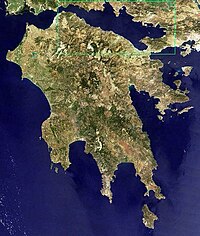
Photo from wikipedia
Abstract The earthquake occurrence in the Corinth Gulf (Greece) is modeled by means of the Linked Stress Release Model, which combines the gradual increase of the strain energy due to… Click to show full abstract
Abstract The earthquake occurrence in the Corinth Gulf (Greece) is modeled by means of the Linked Stress Release Model, which combines the gradual increase of the strain energy due to continuous tectonic loading and its sudden release when an event occurs. The modeling is based on the theory of stochastic point processes and it is determined by the conditional intensity function. The modeled time–dependent seismicity incorporates stress transfer and interactions among the major fault segments that belong either to the western or to the eastern part of the study area. Static stress changes caused by the coseismic slip of eight characteristic events that occurred during the instrumental era were calculated. Their perturbations reveal that earthquakes occurring in the eastern part provoke excitation in the western part while the events that occurred in the western part do not affect the seismicity of the eastern part. This result was taken into account and the values of the model parameters were constrained accordingly. The analysis is also performed on synthetic earthquake catalogs developed by an earthquake simulator algorithm that can replicate the seismic activity in the study area and yields to comparable results.
Journal Title: Tectonophysics
Year Published: 2018
Link to full text (if available)
Share on Social Media: Sign Up to like & get
recommendations!